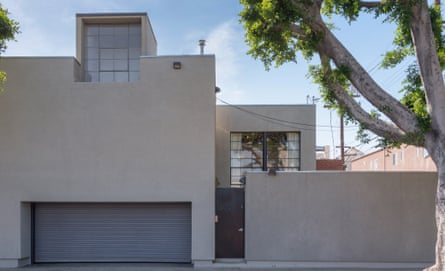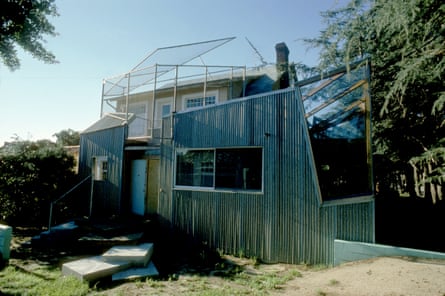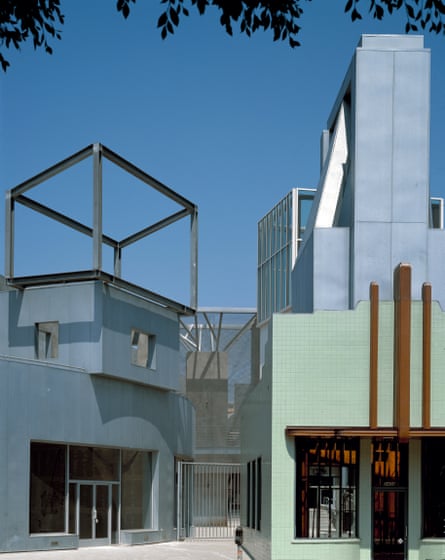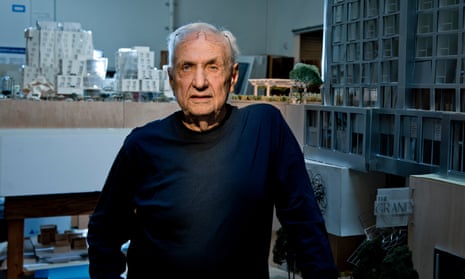“I’ve taken up flying,” says Frank Gehry, aged 89 years and 11 months, as he sits opposite me in his Los Angeles office, “a little bit.” Then he tells a story. How in his youth he had a job washing aeroplanes, and how his cousin had a Waco biplane and would take him up in it. How he wanted to do this again. How the subject came up when Sydney Pollack was making the 2005 film Sketches of Frank Gehry. How the architect asked the film director, did he know someone who had a Waco?
“Yes, he did – Harrison Ford. And I knew Harrison way, way back, when he was a cabinet maker. He bid for some of our projects.” But Gehry never got to fly with the man who played Han Solo. Then, one evening, he was at a dinner party complaining to Ford on the subject when the host chipped in. He had another make of biplane, a Stearman, and was happy to take Gehry into the sky. He shows a photo as proof. “I can’t land it or anything, but he lets me steer it.”
The narrative touches on many aspects of Gehry. He is sociable – his tales tend to involve chains of friends and chance meetings. He has a fascination with celebrity and high-achievers, as many photographs around his office attest: Frank with Herbie Hancock, with Shimon Peres, with champion ice hockey teams, with Princess Diana, with Jasper Johns, with Catherine Zeta-Jones, with Pierre Boulez, with Quincy Jones, with former leaders of Canada and West Germany.
Fame is definitely a thing with Gehry, but an ambiguous one. “You’ve got to realise that this place is still Hollywood,” he says of Los Angeles. “I find that very comforting because there are no spotlights except on Hollywood. It gives you a kind of cloud cover.” He name-drops, but always with an interest in the person as well as the name. He makes it sound both natural and amazing that he knows these people. He equally likes to bring things down to earth (the plane-washing, the cabinet-making). It’s not untypical that a boast (“I’m flying”) is followed by deprecation (“a bit”).
Most of all, the biplane story captures his addiction to adventure, physical, emotional and imaginative. It is why he played ice hockey until the age of 72, and why he still takes Foggy, the 23-metre (74ft) yacht that he designed, out into the Pacific Ocean. He sees such openness to chance in the work of the musicians with whom he loves to collaborate – he’s got a number of designs for performance spaces on the go. “It’s like jumping off a cliff,” he says. “If you know what you’re going to do before you’re going to do it, don’t do it.”
By way of example he describes his work with the jazz saxophonist Wayne Shorter, designing a set for an opera, Iphigenia, that Shorter has written. “The meetings are hilarious,” says Gehry. “I haven’t a clue what they’re talking about. The pianist starts. Wayne stops her. He goes ta-ta-ta. She knows what he means. It goes on like this for four hours. It’s pure sonic invention.”
Leaps into the unknown can be seen in work Gehry did with schoolchildren, in collaboration with his teacher sister, Doreen Nelson, that was captured in a 1972 documentary, Kid City, directed by Jon Boorstin. The children built a city, Purium, out of painted blocks and cardboard, a sort of haphazard anticipation of the architecture Gehry would later do; they debated planning issues and elected a mayor. It was all too chaotic for the children’s regular teacher (and Gehry now regrets his lack of tact with her), who fired the siblings. “The point she missed,” he says in the film, “is that the conflict, when they start arguing with each other, is the real involvement in the city planning process that they were robbed of.”

This early work, for the graphic artist Lou Danziger, beautifully combines workplace, home and courtyard garden. It shows Gehry’s interest in interlocking volumes, even if it has none of the irregular angles that later became his trademark. Fellow architects found it too bold, but many artists loved it. Photograph: Michael McNamara
Gehry’s life story has a number of cliff jumps, which take on a mythic quality in the retelling. One was his name change, from Goldberg. His first wife, Anita Snyder, who like Gehry is Jewish, felt that a less Jewish-sounding name would offer some protection from antisemitism. As she had put up with the stresses of living with a fledgling architect, he felt he owed her something and agreed. But why, of all names, Gehry? He takes a napkin and signs his former and present surnames on it. Goldberg, the way he writes it, has big descending loops on the “g”s at beginning and end, and three verticals – l, d, b – in the middle. The “g” and the “y” of Gehry have the same loops. There’s only one vertical, the “h”, but the architecture of the two names was similar enough to satisfy him.
The most pivotal jump concerns the house in Santa Monica where Gehry lived until recently (they now live in a house designed by their son) with his second wife, Berta, which he remodelled in the 1970s with all the disrespect for convention for which he was not yet world-famous – jagged angles, rough edges, unglamorous materials such as plywood, chain link fencing and corrugated sheet metal. At that time, Gehry had built up a successful practice designing not-bad but not-exceptional commercial projects – apartment blocks, offices, shopping centres – with a sideline doing houses and studios for his artist friends. In 1980 he hosted a dinner at his house to celebrate the opening of a not-bad shopping centre. His developer client looked around him. “Is this what you like?” he asked. Gehry said he did. “Well, if you like this you can’t possibly like that,” said the client, pointing in the direction of the shopping centre, “so why are you doing it?” So Gehry, aged a little past 50, stopped working on all his commercial projects and shrunk his office. He chose, almost, to start over again.
As midlife crises go, it was one of the more creative and productive ones. If Gehry struggled for a while, going through what I’m told were very lean times, he would in time build up a reputation among architectural cognoscenti based on small- to medium-sized projects: more houses, a law school, a library, an ice rink. With the opening of the Bilbao Guggenheim in 1997 his success became both popular and global. This celebrated constellation of titanium and stone, this fantastical ark of art on the banks of the river Nervión, gave its name to a phenomenon – the Bilbao effect – whereby beaten-up old cities would try to reverse their fortunes with spectacular architecture. It became the icon of what would be called iconic architecture.
Other landmarks followed, such as the Walt Disney Concert Hall in downtown Los Angeles, which opened in 2003. (In fact it was commissioned before Bilbao, but drawn out by, among other things, Gehry’s battles to convince clients and funders that he really should be allowed to build it.) By the time Pollack made his feature-length documentary, it was common to call Gehry a “genius”, a “modern master”, “the greatest architect in the world”. He appeared in cartoon form on The Simpsons and was befriended by the architecture-loving Brad Pitt. Later, Mark Zuckerberg paid a visit to his studio, a hangar of controlled creative confusion in what used to be a BMW factory, and said that this was just how Facebook liked to work. He has commissioned 10 projects from Gehry to date, on the tech company’s Silicon Valley campus and elsewhere.
Meaghan Lloyd, a partner in the practice, gives a tour of projects now on the go. There are twin silvery skyscrapers in Toronto, the city of Gehry’s birth. In Arles, southern France, the twisted and glittering tower of Luma, an arts centre founded by the Swiss collector Maja Hoffmann, is nearing completion. The Guggenheim in Abu Dhabi, approaching three times the size of the one in Bilbao, commissioned in 2006 but then stalled, is back on. So is the 447ft-long Eisenhower memorial in Washington DC, which was paused by controversy. Among other things, the general/president’s family didn’t like Gehry’s initial idea of stressing his humble origins in Abilene, Kansas. They wanted something more obviously heroic.

“We’d been told that it was haunted,” says Gehry of the home he remodelled for himself and his family, “so I decided that the ghost was a cubist.” The result was an explosion of everyday building materials around an everyday timber house. Neighbours hated it, sued or threatened Gehry with prison, but it made his name. Photograph: Susan Wood/Getty Images
Gehry, in short, who turns 90 on Thursday, is not slowing down much. He says that he wouldn’t know how to retire. “I love working. I love working things out. I love the client interaction – I think it’s a 50-50 game. I love that we do what we do, and bring it in under budget, which no one believes, but it’s true.”
More than the prestige projects that Lloyd showed me, Gehry wants to talk about his plan for building a community park and cultural centre (among other things) over a section of the Los Angeles River – a 50-mile concrete ditch containing a trickle that sometimes becomes a flood – in the district of Cudahy. He also talks about the conversion of an old bank building into a home for the Youth Orchestra Los Angeles in Inglewood. Cudahy and Inglewood are both places, Lloyd tells me, with “opportunity gaps”.
Gehry particularly likes talking about the Pierre Boulez Saal in Berlin, completed in 2017, where his 90th birthday party will be held. This serves the musical academy that has grown out of the ideas hatched, 20 or more years ago, between the Jewish pianist and conductor Daniel Barenboim and the Palestinian intellectual Edward Said, of overcoming political divides through teaching and performing music. It is a comparatively modest project, being the insertion of a 682-seat auditorium into a former depot for stage sets, but it brings together phenomena fundamental to Gehry: a love of music, a wish to do good in the world, and his own identity and family history as a secular Jew.
“I’m an atheist,” he says, “I don’t care about all that. I saw things happening in Israel that I couldn’t feel good about. But – I’ll start crying – when I was a young kid with my father in a synagogue in Timmins, Ontario, in the 1930s, where I’d been beaten up a lot for killing Christ, he was not school educated, but he got up and made a speech.” It was about the idea of a Jewish homeland in the context of the antisemitism that the family had to face. “The speech was so powerful. It never left me.
“Then I heard that Daniel and Edward Said had a proposal for speaking to each other through music. It was something I totally believed in.” Eventually, through a typically Gehry-esque web of events, chance and connections – including the composer Pierre Boulez and the head of the Juilliard school for performing arts, imaginary concert halls that Gehry asked his students at Yale to design, and an unrealised commission from another client for a concert hall in Istanbul – he was asked to design the new hall. Its final form is a wooden oval, with the audience intimate and close to the performers, and an undulating balcony above. Its geometry, Gehry is delighted to point out, happens to match that of one of the masterpieces of baroque architecture, the church of San Carlo alle Quattro Fontane in Rome.
This was designed by Francesco Borromini, the melancholic 17th-century genius whom Gehry often credits as an inspiration. For all that Gehry personifies a California spirit of invention, he knows his history. He recalls soaking up the stuff when he and Anita Snyder lived in Paris for a year, about 1960. “At the weekends we drove to Brussels, to Holland, wherever we could. I visited the whole of the Loire.” He fell in love with the sculpture of the Romanesque artist Gislebertus in Autun, how it is “tough and related to the architecture”.

Edgemar was a mixed-use development of shops, offices, restaurant, studios and a small museum. If its intimate, irregular open spaces are inspired by Tuscan hill towns, its materials are pure LA. Gehry’s Abu Dhabi Guggenheim clients liked its chain link sun screens so much that they’ll be making a comeback in the Gulf. Photograph: View Pictures/UIG via Getty Images
For Gehry, these past figures are still vital. “This is my north star,” he says, pointing at a large photograph of the ancient bronze Charioteer of Delphi, whose beautiful drapery might be considered a refined cousin of Gehry’s buildings’ folds and crumples. “Fifty years ago I visited Delphi and saw that statue. The label said ‘artist unknown’. It made me cry, that someone could make something with inert materials that could move someone thousands of years later.” Architecture, he believes, belongs in the same company as the charioteer: “There’s historical proof it was considered as art. Somehow it got segued into not being, and being kind of run by commercial culture.”
So the Gehry universe is richly and diversely populated. It includes without much distinction long-dead artists as much as living stars, sportsmen, politicians, musicians – pretty much anyone, famous or not, who is active rather than inert, something rather than nothing. It includes the children in Kid City and the characters in the children’s animation Arthur, in which a cartoon Gehry (with little furry animal ears) helps them rebuild a treehouse. He guides them away from their wilder fantasies (it could be a giant pizza, a space-rocket-castle) towards – because that’s what they really want – something much like the treehouse they had before.
Gehry can make connections between the living and dead and between art forms and cultures. Meeting Jay-Z at a basketball game and not knowing what to say, he asked who was the first rapper, before making his own suggestion: James Joyce. Who’s that, asked Jay-Z. So Gehry sent him recordings of Joyce reciting passages from Finnegans Wake. Jay-Z hasn’t replied yet, even though Gehry got a mutual friend, Bono, who does know who Joyce was, to nudge him.
The architect’s world also includes rogues. Gehry’s career has brought him into contact with President Erdoğan of Turkey, then in his first month in office (“I realised he was a monster”), with President Maduro of Venezuela (“he was scary”), and with Boris Johnson (“what an asshole”, he says, when I describe the MP’s conversion to Brexit). He once declined an invitation from Donald Trump to design the tallest tower in New York. “He just couldn’t deal with being turned down. He said, ‘I’ll do it with or without you.’ He slammed the door on me.” Later, when they happened to meet at some fundraising dinner, Trump turned his chair round to present his back to Gehry. “I said, ‘You don’t need to do that. Be civil.’ He said, ‘I don’t need you.’” But Trump never did build that tower.
Many architects like to talk about the importance of people, but they are often abstract ciphers employed to decorate their visualisations. For Gehry it’s roughly the other way round: his buildings are, like the people who fascinate him, vivid characters. Materials, almost, have feelings. He psychoanalyses chain link, the material with which he was most often associated in the pre-Bilbao, pre-titanium days: “I realised that the world was filled with ugly stuff and nobody seemed to care. There was a lot of denial. I talked to a lot of shrinks about denialism and I got really interested in how that affects architecture.

The titanium-clad art museum that put its host city on the tourist map. A popular and critical success that has been much imitated but never equalled. Such objections as there are argue that the showy architecture overwhelms the art. Gehry’s response is to quote artists – Richard Serra, Cy Twombly – who say they love exhibiting there. Photograph: Alamy
“I said to myself, what is the material that everyone hates the most and uses the most? Bingo! Chain link.”
So he went to the factory that supplied most of Los Angeles’ chain link, with a machine that could make about 15 miles of it per hour. He tried to find ways to make it beautiful – multiplying its layers, getting it to cast cooling shadows, getting it to look like diaphanous veils. He’d get introduced at parties as “the chain link man”. A lawyer friend couldn’t understand this preoccupation, so Gehry pointed out that his tennis court, surrounded with a chain link fence, was visible from every room in the lawyer’s house. “I know you hate chain link,” said Gehry, “I’m sorry, I must have had some effect on you. I must have made you like it.”
His interest in a fencing material was part of a wider interest in the sprawling city around him which, for all that it exports dreams around the world, was not always admired for its physical fabric. Gehry’s earlier work always drew inspiration from Los Angeles: from the way cheap timber-framed construction can look both flimsy and substantial, from the effects of light and shade in the balmy climate, from the things you can do with plywood. Mostly, his fellow architects didn’t understand what he was doing, but the artists that he befriended did. It was about responding to the world as you found it.
At this point, although he was fond of the odd irregular angle, Gehry’s work didn’t have the unpredictable forms for which he became famous. His later projects, more prestigious, more global, are more extravagant in their shape and generous in their specification. He wants everyone to know, however, that he continued to care about the way they are made. Great thought and considerable computing power, he stresses, were put into the rippling form of his 2010 Spruce Street residential tower in New York’s downtown, such that it cost no more than a conventional shape.
He is sensitive to the criticism that his more spectacular work is a series of signature gestures. He hates the label “starchitect” that got stuck to him, along with Zaha Hadid, Rem Koolhaas and others, some time earlier in this millennium. He is, however, able to convey his feelings with humour: once, as I was preparing to take part in a symposium on the sins of starchitecture, a Fedex parcel arrived from his Los Angeles office. It contained T-shirts for the participants, designed by a friend of Gehry’s. “Fuck Frank Gehry”, they said.
For myself, Gehry has always been there. As a student in the 1980s, when postmodernism was bloating, and where there seemed to be precious little inspiration beyond British hi-tech, it was a revelation to find someone who could be so inventive, so enjoyable and so free, while still to the point. His buildings do what they are supposed to do and then add more. They are generous. They are not embarrassed by inhabitation, as some architecture is, but enhanced by it.

Manhattan is the hardest stage on which to design a skyscraper – what can be added to the home of the Chrysler, Empire State and Woolworth buildings? 8 Spruce Street, or New York by Gehry (as the marketing people call it), pulls it off. It is distinctive and new, but seems to belong in its eminent company. Photograph: Jon Hicks/Getty Images
When I left university, I took myself to California and wrote some of my early articles about him, and about like-minded architects around him. Bilbao, not yet tainted by retrospective guilt-by-association with the later absurdities of “iconic” architecture, was another blast of positive energy – here, after decades in which it was a given that anything liked by the architectural community would be hated by the general public, was a critical and popular success combined. It also, as both imitators and critics have failed to understand, is particular to its place. It engages in a robust conversation, a friendly pushing-and-pulling with its neighbours: 19th-century apartments, a big bridge, a river with an industrial past, a craggy landscape.
Sometimes the critics are right. Sometimes the shape-making detaches itself from other forms of reality and becomes a self-referential exercise on its own. It can be a bad sign when Gehry uses metaphors too glibly, when, as with the Louis Vuitton Foundation in Paris or with his IAC headquarters next to the High Line in New York, he says that a building is like the sails of a ship. Images like this can be used to justify almost anything. They can camouflage a lack of what is elsewhere Gehry’s strongest quality, his engagement with what is around.
Recently I went to Arles, to see the not-quite complete Luma arts centre. Gehry says it’s inspired by the paintings of Vincent van Gogh, who lived and worked in the city: its specially deformed stainless steel cladding is designed to reflect the light that he painted. “Look, it’s The Starry Night,” Gehry says of a deep-blue picture of the building that has tumbled out of Instagram. It is, but the nubby tower could just as well be the stump of Van Gogh’s ravaged ear.
It’s mad. It’s excessive. But something wonderful could be climbing out of the building site, in the spaces that are made when the steel nubs intersect with a glass drum at the tower’s base. The deformed steel does indeed do amazing things with light. And you can only admire someone who keeps driving himself to make such things, with all the exposure to criticism and self-doubt it must entail. Beyond that, I’d trust Gehry to do a better concert hall or a better skyscraper than any other architect working today.
I see Frank Gehry on a Monday, the day after he has arrived back from a quick trip to Paris, and again on the Wednesday. He has meanwhile been diagnosed with pneumonia. “I nearly died,” he says. “My doctor said that, if I went to Paris, I might get pneumonia. But I went anyway.” He doesn’t seem too worried: “They’ve got it under control.” Another cliff jumped, then.
Follow Guardian Cities on Twitter, Facebook and Instagram to join the discussion, catch up on our best stories or sign up for our weekly newsletter

Comments (…)
Sign in or create your Guardian account to join the discussion